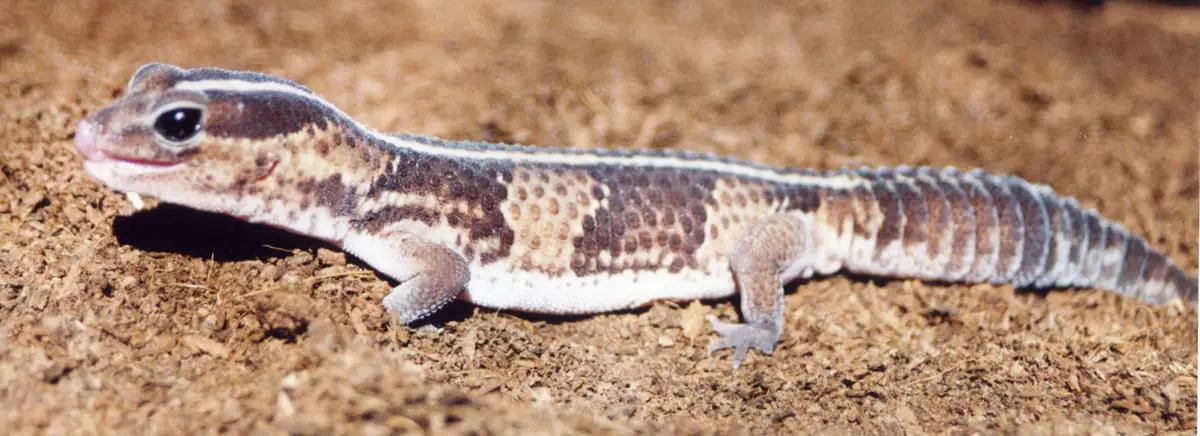
The African Fat Tailed Gecko , scientifically called Hemitheconyx caudicinctus , is perhaps one of the most underestimated and least known lizards not only within Italian terraristics, but also in terraristics in general. However, it can be seen as slowly, its presence is expanding with the passage of time in reptile fairs and in our homes.
In this article we will talk about why this gecko is so extraordinary. We will make an introduction and then talk specifically about how you can properly care for a Fat Tailed Gecko, also called Hemitheconyx caudicinctus.
General Information about the African Fat-Tailed Gecko (Hemitheconyx caudicinctus)
Before we can talk about how to care for this gecko, it is necessary to get to know this creature more closely. Knowing the correct basic information, it will therefore be easier to recreate a right home and adopt the most appropriate behavior for this animal.
The fat-tailed gecko is a lizard that lives in close contact with the earth. This animal comes from the westernmost areas of West Africa. As a habitat it prefers several different conformations of the land, in fact it is possible to find it in very rocky areas, thickets or grasslands. In any case, this gecko always prefers very humid areas , unlike its cousin, the leopard gecko.
The maximum size that this specimen can reach is around 25 – 30 centimeters including the tail, taking into account that however the male is usually larger than the female. Their life expectancy is around 15 – 20 years.
One important thing not to forget is that the fat-tailed gecko is able to separate from its tail, just like its leopard gecko cousin. This can happen when he feels too stressed or threatened, so you should definitely avoid grabbing or holding him by the tail. Be very careful with this factor because after losing the tail, it grows again but with different and not harmonious features as before.
The African fat-tailed gecko is one of the only types of geckos that has eyelids that help protect its eyes from the dusty climate it lives in. Most other geckos do not have this characteristic, in fact they have to continuously lick their eyeballs in order to keep them lubricated.
How to Arrange the Terrarium
It is important to determine how large the terrarium is where the African fat-tailed gecko will live. The minimum size for a terrarium or fauna box must be at least 50 centimeters in length and 30 in width. As the animal grows, it is good to adjust the size of the terrarium by increasing its size. This type of animal does not suffer from too much space, so the larger the terrarium, the happier the gecko will be.
The decor of the terrarium is a fundamental part to make this lizard live the best. It is possible to make it as elaborate as you want, as long as there are at least a couple of burrows. One of the two burrows should be humid, while the other may be drier on the cool side of the terrarium. Next you will need to place a bowl for water and one for food.
For the rest of the arrangement, you can proceed to your liking with various more or less functional decorations.
We always recommend some decorations such as fake plants or trunk pieces, so that the gecko can also hide underneath and feel sheltered.
Temperature
As with almost all exotic animals, the fat-tailed gecko also needs a thermal regulation area . In fact, in the terrarium it is important to have a cold zone, a warm zone and a basking hot spot. The hot zone normally occupies 30 – 40% of the total space available inside.
In the hot area, through the use of a cable, mat or heating lamp, a temperature of about 30 – 32 degrees centigrade must be reached. For the cold zone it is not necessary to use any external temperature source. The heat emanating from the hot area will in fact decrease automatically, bringing the temperature in the cold one to about 24 – 26 degrees centigrade.
At night it is possible to turn off the external heat source, in order to better simulate the temperature range that occurs in nature. However, it is important that the temperature inside the terrarium does not drop below 20 – 22 degrees centigrade.
Substrate
When the gecko is still a cub, it is more sensitive to contact with the substrate. For this reason, we always recommend using a simple substrate different from those indicated for adult geckos, blotting paper or newspaper sheets may be more than enough for the first months. A substrate of this type will also be very easy to clean and change whenever there is a need.
For adults we recommend using a mixture of peat, soil and sand as a substrate. As for the sand, we do not recommend putting too much of it because it could be easily ingested by the animal, so use it only to give a little color and texture to the terrarium.
When placing the substrate, make sure you leave some space to place all the decorations correctly and, if necessary, to build raised shelves or place stones.
Humidity
Humidity is a very important factor to respect in caring for your African fat tailed gecko. Incorrect humidity values could lead to more or less serious consequences on the moult and health of the animal.
The terrarium must always have a humidity level between 50 – 70%. This value can be achieved by spraying water approximately every 5 days. We recommend the use of a hygrometer to be able to monitor the level of humidity inside.
Light
As with the other accommodations, the lighting is also relatively simple to manage as there is no need for special lamps. The fat-tailed gecko needs to know whether it is day or night in order to stay healthy.
To set a correct day-night cycle, simply place the terrarium in a room that remains illuminated during the day, sunlight or artificial light makes no difference. As this type of gecko is a crepuscular animal, it does not need the presence of a UVB lamp.
What Food does gecko Eat?
Fat-tailed geckos are lizards that only eat live insects. Usually they feed on worms or cockroaches, the most common prey to be administered can be not too big crickets, dubia or lateralis cockroaches, caimans, meal moths, honeyworms (infrequently), silkworms and grasshoppers.
For baby specimens, it is advisable to provide small worms as prey every day. You can place a dozen of them in a container inside the terrarium, in this way the gecko can eat whenever it feels the need.
As the gecko gets bigger and bigger, it is possible to reduce the frequency of feeding until you get to feed it once every 3 days. Adult specimens will suffice with 4-5 crickets per meal.
As an integral part of the diet, it is imperative that all insects that are fed as a meal are first sprinkled with calcium powder. Once a week, in addition to the usual calcium powder, it will also be necessary to add some vitamin D3 powder.
Last but not least, make sure the gecko always has access to fresh water. Changing the water in the bowl every night may be more than enough.
Reproduction
Reproduction of the African Fat Tailed Gecko occurs at the same time as most other reptiles. Usually, the mating process takes place in the months between October and March.
When an adult specimen of this species is ready to reproduce, it emits a click-like sound to attract the female. In fact, to conquer the female, this type of lizard uses almost totally vocal calling methods. During the encounter with the gecko of the opposite sex, the male will continue to emit high-pitched noises.
To allow the copulatory act, the male clings firmly by biting the female’s neck and placing his tail under that of the female who helps him by raising his own. In this way the male will be able to insert his hemipenes inside the female gecko.
During the gestation period, it will be possible to locate the eggs by looking under the female’s belly. Gestation can last from 40 to 70 days , but this data is also influenced on the basis of the correct housing of the animal.
If the terrarium has a lower average temperature than usual, for example during the winter period, the gestation could be longer. Females are reproductive about 4 times a year and can have up to 3 pups per brood.
Price of the African fat-tailed gecko
Even if its popularity is growing slowly, this reptile is not yet widespread in Italy. It is therefore currently very difficult to find a specimen of this species of gecko for sale.
If you are lucky enough to get in touch with a breeder or a shop that owns one, the price could range from as little as around 50 euros up to as much as $600.
The price, even for the African fat-tailed gecko as for other reptiles, depends on the age of the specimen and the rarity of the genetic morph it possesses.






